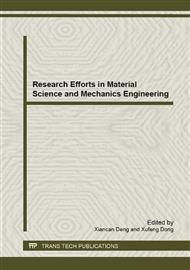[1]
Kawashima F, Igari T, Miyoshi Y et al. High temperature strength and inelastic behavior of plate-fin structures for HTGR. Nuclear Engineering and Design, 2007, 237(6): 591-599.
DOI: 10.1016/j.nucengdes.2006.09.007
Google Scholar
[2]
Carter P, Carter T J, Viljoen A. Failure analysis and life prediction of a large, complex plate fin heat exchanger. Engineering Failure Analysis, 1996, 3(1): 29-43.
DOI: 10.1016/1350-6307(95)00031-3
Google Scholar
[3]
Nakaoka T, Nakagawa T, Mitsuhashi K et al. Evaluation of fatigue strength of plate-fin heat exchanger under thermal loading. Proceedings of the International Conference on Pressure Vessel Technology, 1996, 1: 99-106.
Google Scholar
[4]
Onur S, Faruk S, Erdal C et al. Thermal stress analysis of Wc–Co/Cr–Ni multilayer coatings on 316L steel substrate during cooling process. Materials & Design, 2009, 30(3): 770-774.
DOI: 10.1016/j.matdes.2008.06.004
Google Scholar
[5]
HUANG Zi-qian, HE Yue-hui, CAI Hai-tao et al. Thermal residual stress analysis of diamond coating on graded cemented carbides. Journal of Central South University of Technology, 2008, 15(2): 165-169.
DOI: 10.1007/s11771-008-0032-9
Google Scholar
[6]
LI Jie, WANG Zhi-gang, LAI Yan-qing, LIU Wei et al. Effect of working condition on thermal stress of NiFe2O4-based cermet inert anode in aluminum electrolysis. Journal of Central South University of Technology, 2007, 14(4): 479-484.
DOI: 10.1007/s11771-007-0093-1
Google Scholar
[7]
LI Jie, WU Yu-yun, LAI Yan-qing et al. Simulation of thermal and sodium expansion stress in aluminum reduction cells. Journal of Central South University of Technology, 2008, 15(2): 198-203.
DOI: 10.1007/s11771-008-0038-3
Google Scholar
[8]
LI He-song, MEI Chi. Thermal stress in SiC element used in heat exchanger. Journal of Central South University of Technology, 2005, 12(6): 709-713.
DOI: 10.1007/s11771-005-0074-1
Google Scholar
[9]
Wenchun Jiang, Jianming Gong, Hu Chen, S.T. Tu. The effect of filler metal thickness on residual stress and creep for stainless-steel plate-fin structure. Int Jnl of Pressure Vessels and Piping, 2008, 85(8): 569-574.
DOI: 10.1016/j.ijpvp.2008.02.007
Google Scholar
[10]
Wenchun Jiang, Jiangming Gong, Shan-Tung Tu, Hu Chen. Effect of geometric conditions on residual stress of brazed stainless steel plate-fin structure. Nuclear Engineering and Design, 2008, 238(7): 1497-1502.
DOI: 10.1016/j.nucengdes.2007.11.010
Google Scholar
[11]
Wenchun Jiang, Jianming Gong, Shandong Tu, Qinshan Fan. A comparison of brazed residual stress in plate-fin structure made of different stainless steel. Materials & Design, 2009, 30(1): 23-27.
DOI: 10.1016/j.matdes.2008.04.051
Google Scholar
[12]
Senel M. Thermal elastic-plastic stress analysis of antisymmetric aluminium metal-matrix composite laminated plates under constant temperature change through the thickness. Journal of Reinforced Plastics and Composites, 2003, 22(10): 897-912.
DOI: 10.1177/0731684403022010003
Google Scholar
[13]
Nakagawa F, Nakano Y, Sawa T. Two-dimensional thermal stress analysis of surface mount joints under uniform temperature change. JSME Int Jnl Series A, 1995, 38(4): 425-432.
DOI: 10.1299/jsmea1993.38.4_425
Google Scholar
[14]
Soliman H M, Waheed A F. Effect of differential thermal expansion coefficient on stresses generated in coating. Jnl Material Science and Technology, 1999, 15(5): 457-462.
Google Scholar
[15]
Zhang X C, Xu B S, H D Wang et al. Effects of oxide thickness, Al2O3 interlayer and interface asperity on residual stresses in thermal barrier coatings. Materials & Design, 2006, 27(10): 989-996.
DOI: 10.1016/j.matdes.2005.02.008
Google Scholar
[16]
Williamson R L, Rabin B H, Drake J T. Finite element analysis of thermal residual stresses at graded ceramic-metal interfaces. Jnl of Applied Physics, 1993, 74(2): 1310-1318.
DOI: 10.1063/1.354910
Google Scholar
[17]
Heinzelmann M, Munz D, Yang Y Y. Effect of geometry on the stresses in bonded materials after a change in temperature. Computation Material Science, 1993, 1(3): 259-264.
DOI: 10.1016/0927-0256(93)90018-i
Google Scholar


